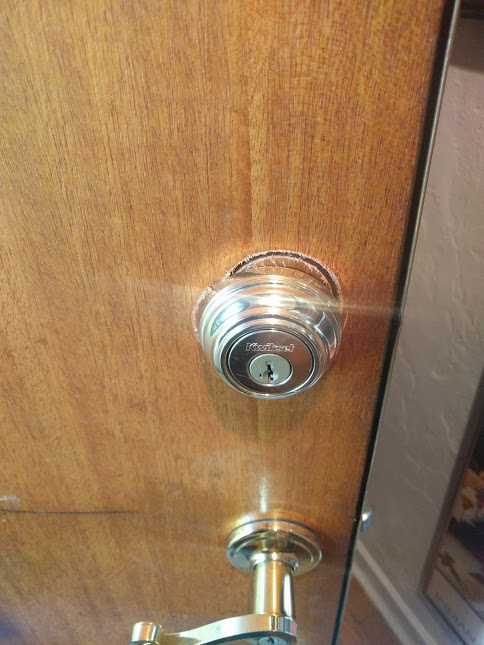“Fresh Installation” means to drill new holes to install a lock. Usually this is done when somebody wants to install a deadbolt above an existing doorknob. Total cost tax already included is:
- $120 Service call to North Seattle
- $60 to drill new holes and install a conventional non-electronic lock in a wooden door
- $75–120 to drill new holes and install a conventional non-electronic lock in a hollow metal or metal-clad door (includes hollow door spacer and hollow frame strike, along with forming edge of door for standard ansi bolt face)
- 50% extra on the weekend and after 6 pm
- $10-75 extra if you provide the lock
- $40-75 to drill new holes and install cabinet or desk locks
Fresh installs in wood doors are just removing the wood so you can put the lock in its place but fresh installs on hollow metal doors require more work. They start out the same: you have to drill the side bore and the cross bore. There the similarities end. One shouldn’t use a drive in bolt on a hollow metal door, instead it is preferable to form a depression in the edge of the door for a full deadbolt faceplate. This may not be possible on some metal doors that are too thick, in that case there are mounting brackets that can support a deadbolt. Either option allows a bolt with faceplate to sit flush on the edge of the door.
The hollow door does not support the deadbolt very well, you can tighten the screws on the deadbolt and never get them tight but instead squeeze the surfaces of the door together. To get around this a spacer must be installed in the hollow part of the door around the deadbolt. Once installed these will keep the door from compressing so you can tighten the lock’s screws. They also serve to prevent the bolt from moving around inside the door and jamming or disconnecting from the lock which can happen if somebody kicks or pries the door. The lock can withstand more abuse with this spacer installed and supporting it.
The strike is also important. The hollow metal frame is going to be stronger than the 1″ by 2″ wood frames used on many doors but it will still be better to use a thimble strike of some kind that allows you to anchor the door frame to the stud behind it.
Sometimes people want me to remove an old lock and install a new one in its place, but the old lock is not a conventional tubular lock with a 2,1/8″ diameter hole. In this case a wrap around plate may be necessary. If a wrap around plate is needed, expect the fresh installation to cost between $25-40 more depending on how much chiseling is required to get the wrap around plate to fit properly.
I wouldn’t blame you if you wanted to save some money. The following information is provided only for your edification, you are responsible for your own idiocy. Doors can be pretty expensive to replace so don’t try drilling holes yourself unless you are pretty confident with a tape measure and following directions. If you screw projects up consistently, don’t try to do this. You know who you are. Try this first on a piece of 2×4. You don’t want your door to look like this:

Most locks come with directions on how to install them. Most helpfully, in the directions there is usually a template that you fold over the side of the door (2023 update: most manufacturers have sadly stopped including these, you’re on your own now). Before you start drilling, look closely at where you want to install the deadbolt. Make sure there are no electrical fixtures near where you want to drill. Make sure no glass is nearby. To use this template you will first need to mark the centers of the holes you want to drill, and then you will need to drill those holes. You should probably drill pilot holes. You will then need hole saws of the correct diameter. This is usually 2,1/8″ and 1″ saws. Drill straight! Drill from both sides of the door or else you may splinter the surface of the door. Send me a picture if you succeeded (also send pictures if it was a dismal failure so I can add them here to warn others in the future)
